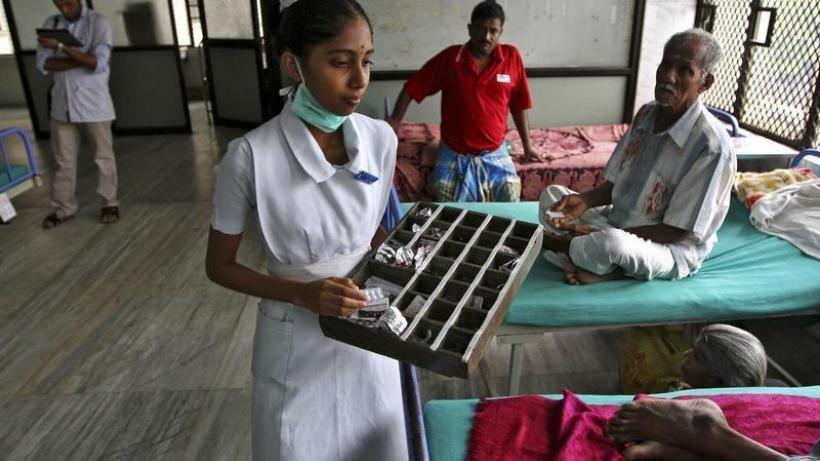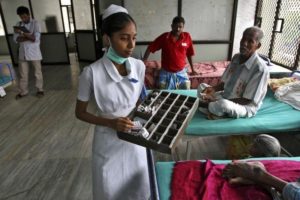
Expanding Indian public health insurance above the poverty line
Since 2008 India’s public health insurance policy has covered the poorest quarter of the population, and the government wants to expand the policy to include households above the poverty line. Disentangling the health and financial effects of the policy is vital to establishing a cost-effective expansion of eligibility for this insurance.
Considering the inherent risks of the economic lives of the poor and the potential for health-care costs to drive households into poverty, health insurance is a key component of financial access. The Planning Commission of India finds that extending quality and affordable healthcare to vulnerable population groups would require securing health insurance for at least 50% of the population by 2020 and 80% by 2030. In order to formulate effective policy for nearly 700 million people, it is vital to understand how care-seeking behaviour changes with and without insurance.
We are currently carrying out a study that examines the health and financial impacts of expanding the Rashtriya Swasthya Bima Yojana (RSBY) to households above the poverty line (APL). RSBY is a centrally-funded, state-run public health scheme in India that provides hospitalisation insurance to households below the poverty line (BPL). We examine not only the impact of RSBY enrolment on APL populations but also insurance uptake and utilisation in those populations. We expect to gain further insight into whether the manner in which health insurance is offered, or subsidised, affects uptake and utilisation.
Parsing the effects of health insurance on health and financial decisions
We explore four research questions:
1) How do uninsured households cope with serious health shocks, particularly those requiring inpatient medical care?
2) How does public health insurance affect care-seeking behaviour, and how does incremental care affect the consequences of health shocks?
3) How does health insurance affect the financial status of households that seek care following a health shock?
4) How does the structure of subsidies for health insurance affect insurance uptake, insurance utilisation, care-seeking behaviour, and health outcomes?
Participants in the study include 11,000 APL households located within 20 km of a hospital registered with the RSBY scheme in the Gulbarga and Mysore districts of North and South Karnataka respectively. APL households are chosen because they are not currently eligible for RSBY coverage and because the Government of India is considering extending public health insurance coverage to APL households. We randomly allocate sample households into four groups:
1) Households receiving free insurance under RSBY,
2) Households receiving an unconditional cash transfer equal to the RSBY premium and the opportunity to buy RSBY at cost,
3) Households receiving only the opportunity to buy RSBY at cost, and
4) Untreated households forming the control group.
Furthermore, we randomly select 150 households to participate in a willingness-to-pay (WTP) group in order to understand how WTP changes over time and in response to sickness and insurance. These responses correspond to the demand for insurance at different rates of subsidisation.
A critical challenge for universal health coverage in India is affordability, raising the question of how insurance should be structured to provide greatest value. We respond to this challenge with treatment groups that obtain RSBY at varying prices: free versus actuarially fair pricing, with or without a cash grant. We obtained high levels and variation of enrolment in insurance across treatment groups — 50-80% enrolment in the various treatment groups versus 40% in the Government of Karnataka’s rollout of RSBY to BPL households. These results increase our chances of detecting any treatment effects of insurance pricing on selection into insurance, utilisation, and health and financial outcomes.
Before memory fades: frequent surveys to ensure robust results
We initially intended to conduct one endline survey, a post-treatment survey of all households in the sample 2 years after they were first offered health insurance under the RSBY. This survey would combine financial, health and cognitive components to provide a comprehensive picture of the value of universal health coverage. However, an endline survey 2 years after treatment raises concerns about the ability of households to recall accurate details of health events and associated treatment decisions. Furthermore, since it is likely that the majority of sample households will suffer no health events warranting hospitalisation, an endline survey might not provide adequate information on the margin of whether to obtain treatment with or without insurance.
To address these gaps in the endline survey, we are about to pilot an innovative approach in the form of a Post Health Events Survey (PHES). The PHES will continuously screen households by phone for whether they have suffered a serious health event in the last eight weeks, following up with a more detailed survey if they have had such an event. It will allow us to gather detailed information from individuals who have had a health event, such as their care-seeking behaviour, satisfaction with care received, usage of insurance, other sources of financing health care, and the consequences of the health event. We expect that surveying individuals within a few weeks of experiencing a health event reduces recall error, which increases over time.
Memories, especially of mundane but important issues such as healthcare-seeking behaviour and financial decisions, fade quickly with time. This issue is particularly problematic because information collected at a later time may be subject to confirmation bias. Households may remember seeking care for events that turned out to have serious long-term effects, but not those which were successfully treated, potentially biasing estimates of the effect of care, and therefore insurance, on outcomes. Moreover, easily forgotten decisions made right after a health shock, such as forgoing days in the hospital, liquidating assets, taking short-term loans, or reducing children’s education or other investments, can have long-term consequences. Phone-based screening is a cost-effective complement to the endline survey and allows us to obtain 66% more post-treatment observations on average than the endline survey. This gain increases the probability that we detect the effects of extending the policy when they do in fact exist.
Expanding RSBY? Preparing for decision time
Extending health insurance to vulnerable APL households cost effectively will require understanding how those households will react to the costs of obtaining and claiming that insurance. Assessing the health and financial benefits of health insurance subsidisation requires frequent surveys to avoid the pitfalls of relying too heavily on people’s inaccurate memory. The results of this experiment will aid policymakers in deciding the extent to which they should offer subsidised health insurance for APL households in order to prevent sudden health expenses driving people into poverty.


